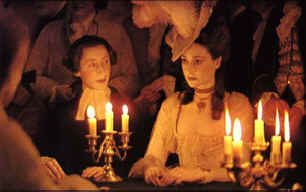Here’s Howard Preston’s tutorial on how many candles would be required to light the faces of the actors in Barry Lyndon–as shot originally vs. shot with a Canon 7D ASA 10,000 and a T2.0 lens.
In our December 2009 issue, page 4, we wrote: The game-changing Canon EOS 1-D Mark IV and Nikon D3s have a normal ISO range of 100-12,800, expandable to 102,400. Those previously unimaginable numbers are astonishing. Consider the great efforts of Stanley Kubrick to shoot by candlelight on his 1975 film Barry Lyndon. He and cinematographer John Alcott, BSC had an f/0.7 50mm ZEISS still lens modified to fit on his non-reflex BNC, using Kodak 5254 Color Negative film, pushed 1 stop (from 100 to 200 ASA). To get more light, the props department made special candles with three wicks— thus boosting the light level from one to three footcandles each.
None of our current lightmeters or Guild Kelly Calculators even approach 102,400. If Kubrick had used a Canon EOS-1D Mark IV on Barry Lyndon, at 12,800 ISO he would have been able to shoot at f/5.6 instead of f/0.7. At 102,400 ISO, he would have been able to gain another 3 stops: f/16. And imagine the money they would have saved being able to use normal, single-wick candles! That would have sacrificed two f/stops: which would have involved opening up another 2 stops…to f/8.
Howard Preston explains:
Use the exposure formula from the ASC manual (p-619 Ninth Edition)
E = 25 f2/( S t )
E = illumination in foot-candles
f = fstop
S = film speed ASA
T = exposure time in seconds
1. Original conditions: F 0.7 Zeiss, ASA 200.
E = 25 x .5 / (200)(1/50) = 3 fc
We need 3 fc to expose the scene. Assume a group of candles is placed about 2 ½ feet from the actors. How many candles are required to provide 3fc?
By definition, one standard candle produces one foot-candle illuminance at one foot. At a distance of 2 ½ feet from the candles, the illuminance is reduced by a factor of 6.3 due to the inverse square law.
The number of candles N that are required is:
N/6.3 = 3
N = 19 standard candles
Kubrick used triple wick candles. Assuming they are three times brighter than the standard candle used in defining the foot-candle, we get N = 6.3 triple wick candles, so round up to seven.
In the clip, there are 8 candles, so we’re at least in the ball park!
2. Shoot the scene with a Canon 7D, ASA 10,000, lens set to T2
E =( 25 x 4)/(10,000 x 1/50) = ½ fc
The number of candles required at 2 ½ ft is N/6.3 = .5 N = 3 standard candles
Looks like we might need some ND’s to keep the shallow DOF.
—————————
About Howard Preston: Howard is president of Preston Cinema Systems, manufacturers of Microforce, FIZ, and other clever camera and lens controls. Howard is one of the top gurus to whom Film and Digital Times turns to for inspiration and explanation. Yes, he holds an advanced degree in physics.
About the framegrab: it comes from a Wikipedia article, and we recognize that “this image is a screenshot from a copyrighted film, and the copyright for it is most likely owned by the studio (Copyright Warner Bros) which produced the film, and possibly also by any actors appearing in the screenshot. It is believed that this low-resolution screenshots for critical commentary and mathematical discussion of the technical issues used to light this shot is acceptable.








